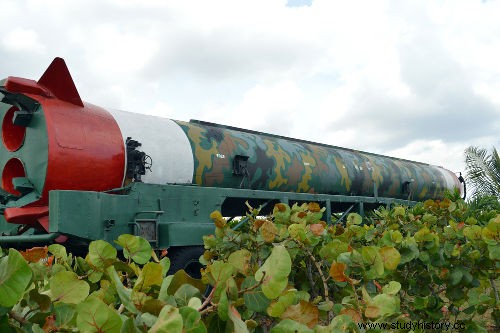
What was the Missile Crisis?
The episode known as “Missile Crisis ” took place between October 16 and 28, 1962. This incident resulted from the discovery of nuclear missile launch pads, models R-12 Dvina (also known as SS-4 Sandal ) and R-14 Chusovaya , both of Soviet manufacture and installed by the Soviet Union on Cuban soil. To understand why this generated the worst crisis of the Cold War, and one of the most tense moments in human history, we need to refer to the phenomenon of the “Race Armamentist ”.
Cold War and Arms Race
We know that World War II ended shortly after the launch of the two atomic bombs , of uranium and plutonium, over the Japanese cities of Hiroshima and Nagasaki , in August 1945, by the United States. The demonstration of the destructive power of these bombs, and the possession that the US had over this technology, provoked the so-called “Arms Race ”, as the then US ally in the war against the Axis Powers, USSR , a few years later broke with the USA and launched the search for the development of nuclear technology. In 1949, the Soviets conducted their first test with an atomic bomb.
The search for more powerful atomic bombs and ways to launch them, such as ballistic missiles, was one of the defining characteristics of the Cold War . In the early 1960s, the two world leaders who fought this technological-military “arm wrestling” were John Kennedy (USA) and Nikita Khrushchev (USSR).
Missiles in Cuba
In 1959, amidst this atmosphere of the Cold War and the Arms Race, the Cuban Revolution , a movement led by characters such as Fidel Castro and Che Guevara who deposed the then president Fulgencio Batista . In 1961, Fidel Castro publicly declared his adherence to international communism and his option for Marxism-Leninism, and four years later he founded the Communist Party of Cuba. Fidel Castro's stance definitely brought Cuba closer to the Soviet Union. As Cuba is a geographically strategic island located in the Caribbean, the Soviets saw in its territory an opportunity to establish nuclear missile bases that would be aimed at US cities.
In the same year, 1961, Cuba suffered an attempt at counterrevolutionary action by anti-Castro Cubans exiled in the US, who were trained by the CIA. This action became known as theBay of Pigs invasion, which resulted in the Battle of Playa Girón . The counterrevolutionaries were defeated. But, given the CIA's relationship with the event, Cuba chose to give space on its territory for the installation of Soviet ballistic missiles, as a way of geopolitically imposing itself on the American continent.
Missile Discovery and the “Black Saturday”
The nuclear missile base was discovered by the US Armed Forces on October 14, 1962 by spy planes, model U-2, which periodically photographed the island. The medium-range missiles could reach the US capital, Washington, in about 13 minutes. After the discovery, President John Kennedy and his commanders chose to establish a blockade against Cuba rather than attack it, while also seeking to negotiate the tension with Nikita Khrushchev.
The negotiations went on for the next ten days. The main requirement for withdrawing the missiles from Cuba was that the US commit to no longer supporting any attempt to invade Cuban territory. It so happens that, when it was thought that the tension was dispersing, on October 27 , a Saturday , one of the U-2 spy planes was shot down by Cuban anti-aircraft artillery, causing the death of the pilot. That was the day when the Missile Crisis reached its peak, that is, on the verge of a “nuclear apocalypse”, provoked by missiles fired by the two superpowers.
Crisis Resolution
On October 28, another condition was imposed by the USSR on the USA:in addition to the commitment not to attack Cuba, the Americans should also withdraw "similar material" (nuclear ballistic missiles) Turkey – country geographically close to Eastern Europe. The deal was sealed and the USSR committed to deactivating and withdrawing its missiles from the Caribbean island.
*Image Credits:Shutterstock and douglasmack
